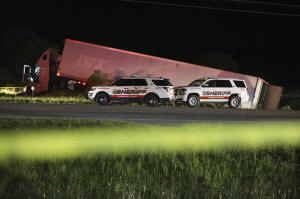His country trained him to fight. Then he turned against it. More like
him are doing the same
 Send a link to a friend
Send a link to a friend
 [October 17, 2024]
By JASON DEAREN, MICHELLE R. SMITH and AARON KESSLER [October 17, 2024]
By JASON DEAREN, MICHELLE R. SMITH and AARON KESSLER
MOUNT OLIVE, N.C. (AP) — The U.S. military trained him in explosives and
battlefield tactics. Now the Iraq War veteran and enlisted National
Guard member was calling for taking up arms against police and
government officials in his own country.
Standing in the North Carolina woods, Chris Arthur warned about a coming
civil war. Videos he posted publicly on YouTube bore titles such as “The
End of America or the Next Revolutionary War.” In his telling, the U.S.
was falling into chaos and there would be only one way to survive: kill
or be killed.
Arthur was posting during a surge of far-right extremism in the years
leading up to the Jan. 6 attack on the U.S. Capitol. He wrote warcraft
training manuals to help others organize their own militias. And he
offered sessions at his farm in Mount Olive, North Carolina, that taught
how to kidnap and attack public officials, use snipers and explosives
and design a “fatal funnel” booby trap to inflict mass casualties.
While he continued to post publicly, military and law enforcement
ignored more than a dozen warnings phoned in by Arthur’s wife’s
ex-husband about Arthur’s increasingly violent rhetoric and calls for
the murder of police officers. This failure by the Guard, FBI and others
to act allowed Arthur to continue to manufacture and store explosives
around young children and train another extremist who would attack
police officers in New York state and lead them on a wild, two-hour
chase and gun battle.
Arthur isn’t an anomaly. He is among more than 480 people with a
military background accused of ideologically driven extremist crimes
from 2017 through 2023, including the more than 230 arrested in
connection with the Jan. 6 insurrection.
At the same time, while the pace at which the overall population has
been radicalizing increased in recent years, people with military
backgrounds have been radicalizing at a faster rate. Their extremist
plots were also more likely to involve weapons training or firearms than
plots that didn’t include someone with a military background, according
to an Associated Press analysis of domestic terrorism data obtained
exclusively by the AP. This held true whether or not the plots were
executed.
While the number of people involved remains small, the participation of
active military and veterans gave extremist plots more potential for
mass injury or death, according to data collected and analyzed by the
National Consortium for the Study of Terrorism and Responses to
Terrorism, or START, at the University of Maryland. START researchers
found that more than 80% of extremists with military backgrounds
identified with far-right, anti-government or white supremacist
ideologies, with the rest split among far-left, jihadist or other
motivations.
In the shadow of the Jan. 6 attack on the Capitol — led in part by
veterans — and a closely contested presidential election, law
enforcement officials have said the threat from domestic violent
extremists is one of the most persistent and pressing terror threats to
the United States. However, despite the increasing participation in
extremist activity by those with military experience, there is still no
force-wide system to track it. And the AP learned that Defense
Department researchers developed a promising approach to detect and
monitor extremism that the Pentagon has chosen not to use.

As part of its investigation, the AP vetted and added to the data and
analyses provided by START, and collected thousands of pages of records
and hours of audio and video recordings through public records requests.
Free of scrutiny in Mount Olive, Arthur stockpiled weapons, some with
the serial numbers scratched off to make them untraceable. He trained a
pack of Doberman pinschers as guard dogs. He rigged his old farmhouse,
where he lived with his wife, their three kids and two children from her
previous marriage, with improvised explosives, including a bomb hidden
on the front porch and wired to a switch inside.
As early as 2017, his wife’s former husband had reported concerns about
his children's safety to military, federal and local authorities,
according to call records and police reports.
All the while, Arthur continued growing his business and connecting with
more like-minded individuals.
In early 2020, a man with a raging hatred for police and an interest in
building a militia in Virginia came to the farm, eager to learn.
A festering problem
Service members and veterans who radicalize make up a tiny fraction of a
percentage point of the millions and millions who have honorably served
their country.
However, when people with military backgrounds “radicalize, they tend to
radicalize to the point of mass violence,” said START’s Michael Jensen,
who leads the team that has spent years compiling and vetting the
dataset.
His group found that among extremists “the No. 1 predictor of being
classified as a mass casualty offender was having a U.S. military
background – that outranked mental health problems, that outranked being
a loner, that outranked having a previous criminal history or substance
abuse issues.”
The data tracked individuals with military backgrounds, most of whom
were veterans, involved in plans to kill, injure or inflict damage for
political, social, economic or religious goals. While some violent plots
in the data were unsuccessful, those that succeeded killed and hurt
dozens of people. Since 2017, nearly 100 people have been killed or
injured in these plots, nearly all in service of an anti-government,
white supremacist or far-right agenda.
A month after people in tactical gear stormed up the U.S. Capitol steps
in military-style stack formation on Jan. 6, the new defense secretary,
Lloyd Austin, addressed the long-festering problem. He ordered a
force-wide “stand down” to give time to local military commanders to
discuss the issue with personnel. He empaneled the Countering Extremist
Activity Working Group to study and recommend solutions. Among the
group’s eventual recommendations was to clarify what was prohibited
under the military’s ban on extremist activity. The revised policy,
released in December 2021, now specifies that anti-government or
anti-democratic actions are violations of the Uniform Code of Military
Justice, federal laws that apply to all service members.
Some applauded the changes, but military and political leaders had been
concerned about extremism in the ranks for years after a wakeup call in
1995 when Army veteran and white supremacist Timothy McVeigh killed 168
people in the Oklahoma City bombing. And the Pentagon, Department of
Homeland Security and a research arm of the U.S. Justice Department have
all funded START’s research.
Bishop Garrison, a U.S. Army veteran and former senior advisor to
Austin, led the working group to address extremism following Jan. 6 and
the widespread unrest in 2020 amid the COVID pandemic and a racial
reckoning.
“We believe the vast majority of people who serve do so honorably, and
this is a small group of individuals having an outsized impact,”
Garrison told the AP. “But we also still need to analyze data to ensure
that our hypothesis is correct and supported by fact.”
Yet a chief hurdle cited by Pentagon officials has been a lack of data –
how to understand the scope of extremism in the ranks when there are
millions of active-duty service members across all of the branches?

“What’s vexing about this is we don’t have a great sense of the scope of
the problem,” then-Pentagon spokesman John Kirby told CNN in the weeks
after Jan. 6. “Many of these people … work very hard to conceal their
beliefs. We can’t be the thought police.”
The Pentagon did develop at least one way to detect extremist incidents
across military branches and among civilian defense contractors. But it
isn’t using it.
The method was revealed in a research memo published the summer after
Jan. 6 that, until now, has not been released publicly. American
Oversight, a nonpartisan watchdog group, obtained the memo through a
Freedom of Information Act lawsuit it brought against the Pentagon and
shared it with the AP.
In a project that began in September 2020 and lasted into 2021, DoD
researchers studying “insider threats” and other security issues in the
workforce developed a way to mine data from a DoD security clearance
database to identify white supremacist and extremist incidents. This
database included details from security incident reports filed about
people who held security clearances — a wide swath of the military
population, civilians and contractors included.
The operation identified hundreds of reported incidents of white
supremacy and anti-government and other extremist activity over 20 years
— the kinds of internal red flags that could identify issues with
service members.
The researchers, whose names were redacted, wrote that the results were
a first step toward developing a way to identify incidents of extremism,
and that the method could be used in other DoD databases.
And while the research was shared among some departments in the DoD
after Jan. 6, it never made it to Garrison, who was leading the
Pentagon’s extremism working group, he told the AP. He called the
oversight “problematic” given his, and the working group’s, mission.
“I am very surprised by the existence of the report.”
A defense official did not address why the report was not sent directly
to the working group. In a statement, the official said the DoD is
“committed to understanding the root causes of extremism and ensuring
such behavior is promptly and appropriately addressed and reported to
the proper authorities,” and that the department has enhanced its
ability to track extremism allegations.
‘Very violent and very ugly’
Arthur’s young children sat atop a blue plastic tub on his farmhouse’s
porch in Mount Olive, their feet dangling as their older sister tied
their shoes. In the tub was an improvised bomb that Arthur had wired to
a switch inside the house, according to evidence presented at Arthur’s
trial.
“They would swing their feet as kids do and pop holes in it. I wasn’t
very careful around (the explosives),” the older sister, the daughter of
Arthur’s wife and her ex-husband, told the AP. The AP is not naming the
children interviewed for this story because they are minors.
As an Army cavalry scout who served two tours in Iraq, Arthur learned
more specialized skills than an average soldier, such as how to rig
improvised explosives. He left the National Guard in 2019 to focus
full-time on Tackleberry Solutions, his military tactics business where
he sold access to this deadly expertise. Tackleberry was Arthur’s
nickname in the Army, after the gun-loving veteran in the “Police
Academy” films known for using inappropriately aggressive military
tactics in civilian contexts.
After leaving the Guard, he also turned his attention to local politics.
Arthur, a former deputy sheriff himself, backed a “constitutional
sheriff” candidate who believed sheriffs, not federal or state law
enforcement, held ultimate authority in the U.S. He tried to enlist
county officials, according to court documents, to aid in creating a
militia to guard against the “tyrannical government.”

“You’re gonna have to secure your smallest municipality and governing
body first, that means townships or cities will have to be conquered
immediately through force,” Arthur said in a video posted just after he
left the Guard.
“Whatever you do, it has to be very violent and very ugly.”
Arthur’s videos had become increasingly unhinged, said Ben Powell, who
was hearing from his children that there were explosives hidden
throughout the farm. Powell’s son said he often used a hand-cranked
wringer in the “bomb shed” to dry his clothes. The wringer sat near a
barrel of the explosive Tannerite and Arthur’s storage area for his
homemade grenades and pipe bombs.
“The older I get, the more screwed up I see the stuff is,” the son, now
in his teens, said.
Powell drove a truck as a civilian DoD contractor at the Tooele Army
Depot in Utah. He said he felt a professional responsibility to report
Arthur after watching the videos, and hearing stories from his kids
about the goings on at the farm.
“That’s kind of what I’m supposed to do, is report if there’s issues,
especially if it’s an inside threat, like a guy in the military,” he
said.
He called an Army “I Salute” hotline set up to receive “suspicious
activity” reports, and an intelligence hotline.
“I called and said, ‘You guys need to do something before somebody gets
hurt. He’s talking about killing cops. He’s talking about killing the
FBI.’”
He’d called the North Carolina National Guard previously with his
concerns, and not seen any action. So Powell told his supervisor at the
Utah Army depot about Arthur, and showed some of the videos. Still,
there was no response. The North Carolina National Guard and the U.S.
Army said they did not have any records of discipline involving Arthur.
Heather J. Hagan, an Army spokeswoman, would not comment on the
particulars of Arthur’s case but said “we do forward all information to
our law enforcement partners when appropriate.”
Things continued to escalate quickly. Arthur and his wife pulled the
kids from the public school and began home-schooling them, with no input
from Powell.
In March 2020 Powell spoke with the Duplin County Sheriff’s Department,
where Arthur had worked briefly as a deputy in the 2000s before he
joined the Army. Powell had not spoken with his children since
Christmas, and was worried.
He asked for officers to make contact with the children to check their
welfare. The sheriff did not respond to a request for comment, but
provided records showing that a deputy reported seeing the children at
the farm in March 2020. The deputy determined the children “appear to be
well taken care of” and took no further action.

[to top of second column]
|

The Livingston County Sheriff’s Office works at the scene of a
tractor trailer after driver Joshua Blessed was killed during a
shootout with law enforcement officers on Rt. 20A in Geneseo, N.Y.,
on Thursday, May 28, 2020. The incident started in LeRoy, N.Y., when
police stopped the tractor trailer for speeding. Blessed took off
and drove into Livingston County, leading law enforcement on a
chase. (Tina MacIntyre-Yee/Democrat & Chronicle via AP, File)

That same month, a man came for an extended stay at Arthur’s farm.
Joshua Blessed slept on a cot in the kitchen and refused to talk to
Arthur’s wife or children. During the day, he would disappear with
Arthur for long training sessions in wartime tactics.
The fatal funnel
Weeks later, Blessed raced his tractor trailer down a rural highway
between Buffalo and Rochester in upstate New York, firing a pistol
out his window at the parade of police cars behind him.
The sleepy evening in LeRoy, New York, in May 2020 had been
disrupted when an officer pulled Blessed over for speeding. After a
brief verbal exchange, Blessed drove away with the officer still
standing on the truck’s running boards, forcing him to jump off the
moving rig.
Blessed, a 58-year-old truck driver and former security guard from
Virginia, had spent years posting conspiracy-laden videos that
vilified law enforcement.
Now he was leading more than 40 officers on a high-speed chase and
gun battle, ramming multiple squad cars that tried to slow him down.
The FBI’s office in Richmond, Virginia, had looked before at
Blessed, who also went by Sergei Jourev. In April 2018, they’d
learned that he was attempting to organize a militia extremist group
in preparation for “The Army of God, for the upcoming Civil War.”
Blessed eventually found Arthur and traveled to his farm to learn
about improvised explosives and other deadly warfare tactics. The
two had continued texting in the weeks before Blessed’s trip to New
York about the technical details of gunpowder, igniters and how to
make Claymore mines, which spray shrapnel.
“Unfortunately, he knew what he was doing,” said Livingston County
Undersheriff Matthew Bean, who was among those involved in the
response.
Midway through the chase, Blessed stopped his rig, blocking a narrow
highway onramp and trapping pursuing vehicles behind him. He’d also
turned the truck’s cab at a slight angle to see the patrol cars
behind him.
Then he opened fire, his bullets pelting the pursuing cruisers.
It was a “fatal funnel,” the tactic Arthur taught that was meant to
make single combatants facing a much larger force more deadly.
However, during the gunfire an officer managed to make their way
around to the truck’s passenger side, surprising Blessed, who drove
off. Police vehicles forced him from the interstate onto a road that
crossed through farms. Officers waiting there fired their weapons as
Blessed’s truck roared by.
Finally, the truck crashed into a ditch off the road. The
bullet-scarred cab pulsed with police lights as rattled officers
approached cautiously on foot. Inside, Blessed was slumped over
dead, shot in the head.
It was “divine intervention” that no officers were hit by the truck
or Blessed’s bullets, Bean said. Ammo struck at least five law
enforcement vehicles, according to police reports; a forensics
report found a bullet lodged in an officer’s backpack on the
passenger seat next to him.
“All 40 men and women who responded had some kind of post-traumatic
stress disorder from that incident,” said Bean. Two left law
enforcement because of it, he said.
Investigators figured that Blessed had been planning a much larger
attack.
A few months later, on Jan. 6, Arthur’s apocalyptic visions of the
future began to play out when many like-minded men and women stormed
the U.S. Capitol. Arthur wasn’t in Washington, D.C., he said, but
the aftermath found him almost immediately.
Federal agents were knocking on the doors of his fellow militia
members in North Carolina, he said, and his own actions would come
under tighter scrutiny.
In Blessed’s truck, investigators had found two how-to explosives
and military tactics manuals for which he had paid $850 from
Arthur’s Tackleberry Solutions. They would find $125,000 in cash, 14
live pipe bombs, an AK-47 with a scope, a .50-caliber rifle, a
sniper rifle and tens of thousands of dollars in ammunition.
Years had passed since Powell reported Arthur to multiple military,
local and federal law enforcement agencies. Powell said he called
the U.S. Army, FBI, the U.S. Bureau of Alcohol, Tobacco and Firearms
and others so many times that he lost count.
“And there was nothing,” Powell said. “There was no response.”

When asked about Powell’s reports, an FBI spokesperson in Charlotte
said the agency would not provide information beyond what was
published in court records. An ATF spokesperson in North Carolina
said there was no record of them opening a case.
Indeed, federal law enforcement agencies have a questionable recent
history assessing domestic terrorism threats accurately. The FBI
assessment of domestic violent extremists written before the Jan. 6
attacks reported, incorrectly, the participants’ “low willingness to
take action in response to a disputed election result” and “those
who are interested lack the capability to carry out anything beyond
a simple attack.”
And before the white supremacist “Unite the Right” violence in
Charlottesville in 2017 that killed a woman and left others severely
injured, the Department of Homeland Security had focused much of its
threat assessment on the dangers posed by far-left counterprotesters.
After years of missed opportunities, the FBI was investigating
Arthur. “It takes over 100 rounds and Joshua Blessed is shot and
killed,” Powell said. “It takes cops getting shot at on public
roadways during a high-speed chase with a 40,000-pound truck. That’s
what it takes before anybody even looked into this.”
‘Buckshot’
On May 5, 2021, Michael Thompson drove to a wartime tactics training
session in Mount Olive. He pulled his truck up to the small,
single-story farmhouse Arthur’s grandfather had built.
It was a year after Blessed’s rampage in upstate New York and just a
few months after Jan.6. Thompson had contacted Arthur through the
Tackleberry webpage.
They approached each other warily.
With a chuckle, Arthur assured Thompson that he wasn’t a cop.
“You never know man, these days,” Thompson said.
“No you don’t.… And the thing is, that half the cops are good guys,
and half are the bad guys,” Arthur said. “But if I don’t know who’s
good and who’s bad, I’m just gonna walk in and clean house.”
As the two men became acquainted, Arthur claimed to have built a
local militia with other highly trained veterans including a Navy
SEAL, an Army Ranger and a couple of Marine veterans in the area.
One of his military buddies he called “Priest” stayed at the farm
and trained too, according to both children who spoke to the AP.
“Every night at about 10:30, (Arthur) would go out into the shed and
open up his radios and would just call out and touch bases with a
whole bunch of other people. To kind of bring together the militia
that come together and exchange information,” said Powell’s
daughter, who often sat with Arthur during these communications when
she couldn’t sleep.
Thompson had contacted Arthur saying he needed to prepare for battle
against federal agents. ATF agents confiscated some of his guns
while he was out and his wife was home with their children alone, he
said. They were coming back. This time he wanted to be ready.
Arthur and Thompson discussed using hidden, improvised explosive
devices, and how Thompson could transform his house into a “spider
web” of fatal booby traps meant to kill raiding federal agents.
Thompson was wearing a wire for the FBI under the code name
“Buckshot.”
“I want to show you something called a spider web,” Arthur said.
“This was something I built for a fellow recon buddy of mine.”
“It is a freakin’ death box.”
Thompson and Arthur talked for hours, eventually settling into seats
in the house with Arthur’s kids swirling around. Then talk turned to
assassination; using snipers and hidden explosives against
well-guarded politicians, according to the recordings.
Arthur said such killings will be necessary in the coming civil war
— and that snipers are most effective, in many cases.
“I know if I can put a round right there in the base of the
windshield where it meets the dashboard. I’ll hit him. So is the
sniper hit better? Yes.
“Say it’s a whole walled-off gated house … The governor’s mansion.
Alright, how do I attack him? Well, he’s going to have to leave to
go to the Capitol at some point, right?” Arthur said, his wife and
children nearby talking about school and working in the garden.
It is these targeted attacks that the data show people with military
backgrounds are making more successful. Those include the 2020
murders of a federal security officer and a sheriff’s deputy in
California by an active-duty Air Force staff sergeant and the 2018
attack by a former Army soldier who shot six women at a Florida hot
yoga studio, killing two, before he killed himself.

When military members are involved, the plots are more likely to
seek and inflict mass casualties — and in an election year it is
this kind of attack that worries people who are studying how
military expertise is influencing extremist action. A mass casualty
attack is defined as one that kills or injures four or more people.
“My primary concern is not a march on the Capitol or any other
government building. It’s that somebody with the skills that were
imparted on them by the military to be extremely lethal uses those
skills,” said START’s Jensen.
“And they go out and attack civilians and have a real impact on
public safety.”
Armed with Thompson’s recordings, FBI agents planned for a way to
arrest Arthur safely — a threat assessment of the farm had
determined it was too dangerous to try it there.
The informant told Arthur to meet him at a gun show in Raleigh. He
said he had contacts there who would buy some Tackleberry manuals.
Arthur met Thompson at the event entrance and the two passed through
metal detectors — Arthur wasn’t armed. A SWAT team waiting inside
surprised Arthur, who initially resisted attempts to restrain him,
agents said. Officers then forced Arthur to the ground, and arrested
him.
At the same time, bomb disposal teams were searching Arthur’s home.
They found sandbags and cans filled with Tannerite — which, if hit
by gunfire from afar, can explode. The teams also discovered the
pipe bomb wired to a switch on the porch.
‘You took the oath’
In May, U.S. District Judge James C. Dever III sentenced Arthur to
25 years in federal prison after a jury convicted him on charges
related to teaching the FBI’s informant how to make bombs meant to
kill federal law enforcement officers, as well as illegal weapons
possession.
Prosecutors said they’d found improvised grenades and other “mass
casualty” and “indiscriminate” weapons on Arthur’s farm.
A psychological workup found no evidence of mental illness, but did
cite likely war trauma as a factor in Arthur’s paranoia. Still, the
conclusion was that Arthur did not need “acute mental health
treatment.”

Dever, also a veteran, told Arthur that his specialized military
training in explosives and other warfare techniques made his conduct
that much more serious.
“You took the oath that all of us who served took,” Dever told
Arthur. “You know better.”
But Arthur is unrepentant.
In messages to AP from a federal prison in Tennessee, he said he is
a target of “political warfare.”
“I’m a political prisoner,” he wrote, echoing the language former
President Donald Trump and others have used to minimize the crimes
committed in the attack on the U.S. Capitol on Jan. 6.
In Arthur’s view, the imprisonment of “vets and patriots” like
himself and the attempted assassination of Trump in Pennsylvania
prophesy the civil war he has long argued is coming.
“This is happening,” he wrote. “All the signs are there.”
___
Kessler reported from Washington, D.C. Contributing to this story
were Rhonda Shafner, Michael Rezendes and Marshall Ritzel in New
York, Serginho Roosblad in San Francisco, Allen G. Breed in Mount
Olive, N.C., Rick Bowmer in Salt Lake City, and Michael Kunzelman,
Lolita Baldor and Tara Copp in Washington, D.C.
___
The Associated Press receives support from several private
foundations to enhance its explanatory coverage of elections and
democracy. See more about AP’s democracy initiative here. The AP is
solely responsible for all content.
All contents © copyright 2024 Associated Press. All rights reserved |